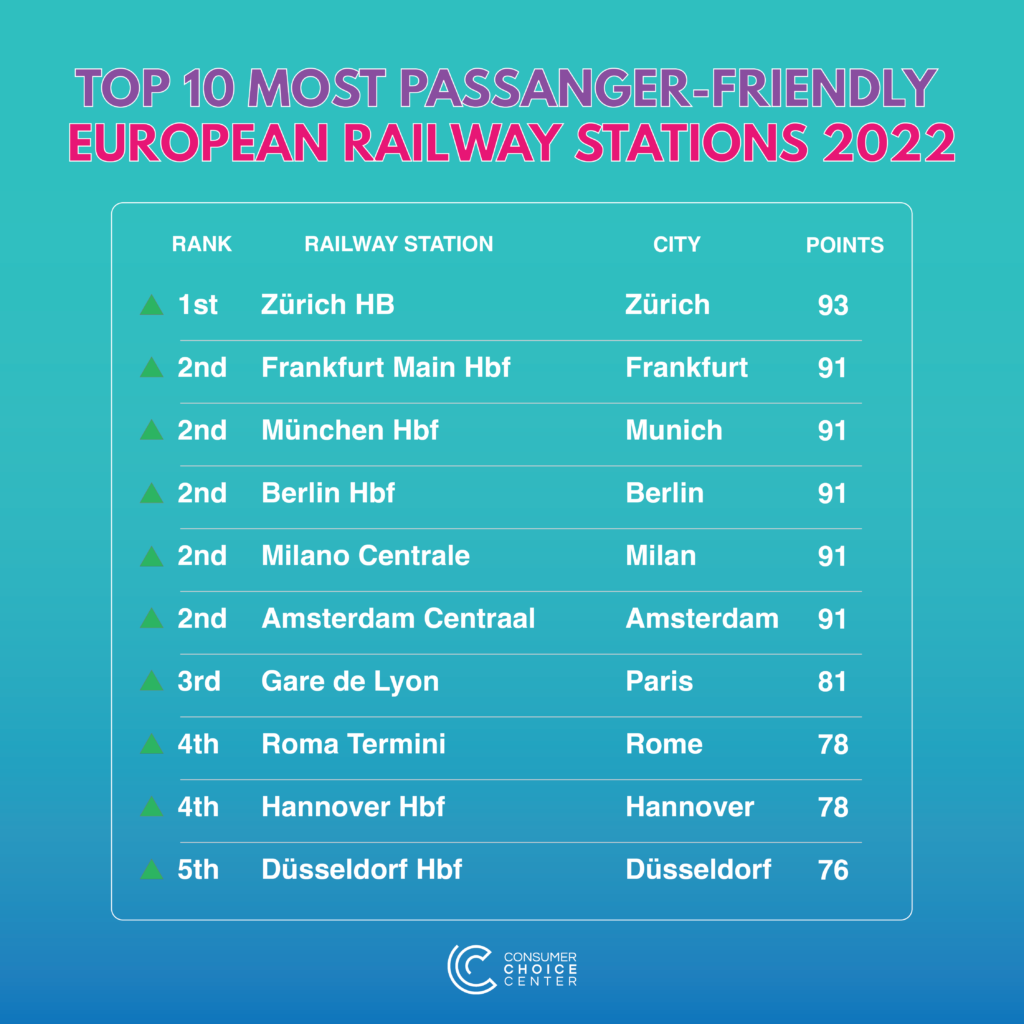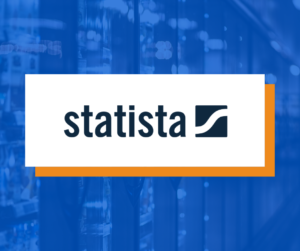
Now that most European countries have lifted their coronavirus restrictions, life in Europe is (somewhat) back to normal. At the same time, the Russian aggression against Ukraine has created, apart from death and destruction, one of the largest refugee crises in recent times. European train stations have faced an unprecedented influx of passengers. Free Wi-Fi, wheelchair access, the availability of shops and kiosks, among other things, is important for consumers in peaceful times. In a time of war, they can be life-saving.
Inspired by our previous two European Railway Indices and the European Consumer Airport Index, we looked at Europe’s 50 largest railway stations and ranked them in terms of passenger experience and a mix of factors ranging from how crowded platforms are and accessibility to the number of destinations.
This is the third Annual Edition of the European Railway Station Index, seeking to rank Europe’s most passenger-friendly railway stations. We found data on the stations’ websites, online statistics, and conducted our own research to collect all necessary information. We have also considered the feedback we received from the media and the public on the first edition and did our best to improve it.
Due to Russia’s military aggression against Ukraine, we removed Russia from the Index and added a few more European stations instead. Furthermore, as we discovered last year, Russian train stations are not transparent and honest about their characteristics, which skewed the results of our last year’s index. Therefore, we also cancel the titles of Moscow Kazansky and Moscow Kursky train stations as the 4th and 6th best train stations in Europe. Moving forward, Russia will not be included in the Index.
Research Note: We strive to improve the quality of the underlying data of this index year by year and aim to refine its methodology moving forward. We sometimes faced contradictory information and indicators measured differently by different railway stations and companies (e.g. number of destinations). We ask the readers of this index to acknowledge the difficulties of working with heterogeneous data and caution users of this index to be aware of the underlying data complications.
Last year, we received an overwhelming amount of feedback from train enthusiasts, which has helped us to improve this year’s Index. However, limited access to local information remains a hurdle for our research. We announce a call for volunteers who would be keen to help us next year. Please fill out the form:
Overall Score: Top 10 Railway Stations for Passenger Convenience in Europe
Overall Passenger Experience Index (includes the above-mentioned indicators but also adds the availability of ride-hailing services, competition of train companies, on-site restaurants and take-away spots and shopping, number of domestic and international destinations, wheelchair accessibility, the existence of first-class lounges, Wi-Fi, and convenience and choice in accessing the platforms). To ensure our data is rigid and the results are unbiased, this year, we included the number of all tracks on station –not platforms. The number of domestic destinations doesn’t include suburbs. This year’s Index also features information about the availability of information in English, which we didn’t include in the final scoring.
Zürich HB in Zurich, Switzerland leads the list of best railway stations in Europe. Even though the station doesn’t have the highest number of international and domestic destinations, it has a high number of shops/kiosks and restaurants and take-away spot places for consumers to choose from.
Germany’s three train stations Frankfurt Main Hbf, München Hbf, Berlin Hbf, and Milano Centrale, and Amsterdam Centraal have ranked second. In the past, all these stations ranked high too. The change in the ranking is mainly due to the improved and updated data.

DOWNLOAD THE REPORT AND DATABASE
MEDIA HITS
- April 1, 2024
- Railway Stations Index, Recent Media
- February 9, 2024
- Railway Stations Index, Recent Media
- January 22, 2024
- Railway Stations Index, Recent Media
- January 22, 2024
- Railway Stations Index, Recent Media
- December 22, 2023
- Railway Stations Index, Recent Media
- December 22, 2023
- Railway Stations Index, Recent Media
- December 22, 2023
- Railway Stations Index, Recent Media
- December 22, 2023
- Railway Stations Index, Recent Media
- December 5, 2023
- Railway Stations Index, Recent Media
- December 5, 2023
- Railway Stations Index, Recent Media
- December 5, 2023
- Railway Stations Index, Recent Media
- December 5, 2023
- Railway Stations Index, Recent Media
- August 21, 2023
- Railway Stations Index, Recent Media
- December 20, 2022
- Railway Stations Index, Recent Media
- December 5, 2022
- Railway Stations Index, Recent Media, Transportation
- October 10, 2022
- Railway Stations Index, Recent Media
- August 8, 2022
- Railway Stations Index, Recent Media
- August 8, 2022
- Railway Stations Index, Recent Media
- July 5, 2022
- Railway Stations Index, Recent Media
- July 5, 2022
- Railway Stations Index, Recent Media
- July 5, 2022
- Railway Stations Index, Recent Media
- July 5, 2022
- Railway Stations Index, Recent Media
- June 23, 2022
- Railway Stations Index, Recent Media
- May 18, 2021
- Railway Stations Index, Recent Media, Transportation
- May 18, 2021
- Railway Stations Index, Recent Media
- May 17, 2021
- Railway Stations Index, Recent Media, Transportation
- May 3, 2021
- Railway Stations Index, Recent Media, Transportation
- May 3, 2021
- Railway Stations Index, Recent Media, Transportation
- May 3, 2021
- Railway Stations Index, Recent Media, Transportation
- May 3, 2021
- Railway Stations Index, Recent Media, Transportation
- April 27, 2021
- Railway Stations Index, Recent Media, Transportation
- April 21, 2021
- Railway Stations Index, Recent Media, Transportation
- April 19, 2021
- Railway Stations Index, Recent Media, Transportation
- April 19, 2021
- Railway Stations Index, Recent Media, Transportation
- April 19, 2021
- Railway Stations Index, Recent Media, Transportation
- April 19, 2021
- Railway Stations Index, Recent Media, Transportation
- April 19, 2021
- Railway Stations Index, Recent Media, Transportation
- April 12, 2021
- Railway Stations Index, Recent Media, Transportation
- April 12, 2021
- Railway Stations Index, Recent Media, Transportation




































